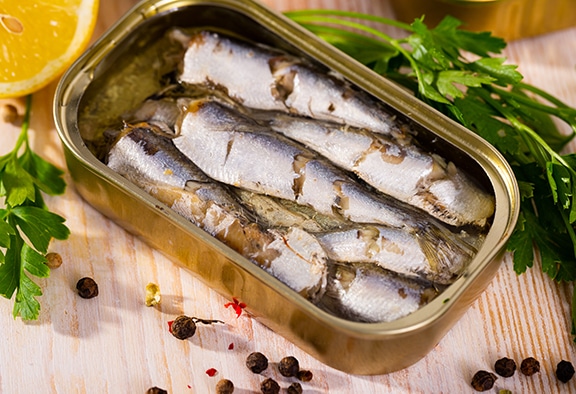
If you’re planning a healthy diabetes diet, you may already know about the health benefits of fish. That said, have you considered eating sardines? While these aren’t the most popular type of fish on the market, they could be the key to improved diabetes management.
As many people with diabetes know, fish are a great source of protein for people managing this condition. While some types of fish are fattier than others, that’s far from a dealbreaker. That’s especially true since the fat they offer, Omega-3 fatty acids, is a type of “good” fat that comes with essential health benefits of its own.
However, one of the most nutritious fish species for people with diabetes is commonly overlooked – namely, sardines. If you haven’t eaten sardines before, we can walk you through the health benefits they provide and help you add them to your diabetes meal plan.

How Sardines Can Help You Manage Diabetes
Many types of fish can simplify diabetes management, but sardines are a uniquely nutritious option in this category. If you have diabetes or risks of type 2 diabetes, sardines can:
Improve Your Heart Health
The Omega-3 fatty acids in sardines have anti-inflammatory benefits. As a result, they’ll be able to help you lower your risk of heart disease. That’s especially important for people with diabetes since heart disease is an unfortunately common diabetes complication.
Additionally, Omega-3 fatty acids can help you reduce your blood pressure and reduce your risk of blood clots. These benefits will all go a long way towards helping you stay heart-healthy with diabetes.
Provide The Calcium You Need
Another potential complication of diabetes can be osteoporosis. People with diabetes, primarily type 1 diabetes, can have poor bone strength and a heightened risk of fractures. These bone-related risks are even higher for people who have had diabetes for a long time and have poor blood sugar control.
Fortunately, adding calcium and vitamin D to your diet is an easy way to protect your bone health. Sardines are typically eaten whole – including their bones. That makes them a phenomenal source of calcium, especially for people who have issues eating dairy products. These fish have a decent amount of vitamin D, too.
Lower Your Type 2 Diabetes Risk
Many of the health benefits associated with sardines can be helpful for all sorts of people, whether or not they have diabetes. What you might not know is that regularly eating sardines may lower your likelihood of developing type 2 diabetes.
One recent study, focusing on 152 people, aged 65 years and older who had been diagnosed with prediabetes, focused on how eating two cans of sardines in olive oil a week would affect participants’ diabetes risk. At the start of the study, 37 percent of participants in the sardine-eating group had a high risk of diabetes. After a year, just eight percent of participants in this group remained at high risk.
Other Perks of Eating Sardines
Of course, the benefits of eating sardines don’t stop there. When you make these fish part of your diet, you’ll get:
Lots of Nutrients
Along with the vitamins and nutrients listed above, sardines are an excellent sources of:
- Vitamin B-12
- Phosphorus
- Zinc
- Selenium
- Magnesium
- Potassium
- Iron
- Niacin
- Iodine
Low Mercury Levels
One common concern related to fish is their mercury levels. The good news is that sardines only feed on plankton. As a result, they have considerably lower levels of mercury than some types of fish do.
Low Cost
If you’re trying to eat a diabetes diet on a budget, it’s hard to go wrong with sardines. These fish are a highly affordable source of irreplaceable nutrients.

Great Ways to Eat Sardines
Sardines aren’t finicky when it comes to preparation. Fresh sardines should be gutted and rinsed under cold water before serving, but canned sardines only need a quick rinse ahead of time. When your sardines are ready, here are just some of the ways you can enjoy them:
- Sprinkle sardines with extra virgin olive oil and lemon juice.
- Mix sardines with chopped onion, olives, or fennel.
- Cover sardines with chopped tomatoes and herbs like basil, oregano, and rosemary.
- Balsamic vinegar gives sardines a delightful taste.
- Make a sauce with extra virgin olive oil, lemon juice, pressed garlic, Dijon mustard, and salt and pepper. Serve over sardines.
- Pan-fry whole sardines until crispy and mix with a warm salad of chickpeas, cherry tomatoes, and parsley.
- Make a Greek-inspired mix of warm sardines, crunchy cucumbers, chickpeas, and feta.
- Whole canned sardines are mixed with avocado, radish, and watercress for a salad full of complementary textures and flavors.
- Eat sardines on whole-grain Scandinavian-style crackers such as Wasa, Ry Krisp, Ryvita, or Kavli for a protein-packed and portable snack. Squeeze lemon juice on top.
- For a sardine sandwich: 1 serving, mash 2 ounces low-fat cream cheese with 1/2 teaspoon onion powder, 1/4 teaspoon garlic powder, and 1/8 teaspoon cayenne in a small bowl. Spread the mixture on a slice of pumpernickel and top with a couple of drained, canned sardines.
- For breakfast, revamp a favorite meal like an omelet with sardines instead of smoked salmon.
Now, if you have kidney problems or gout, you should avoid sardines. They naturally contain a substance that creates uric acid. And be sure to read the Nutrition Facts label and eat the correct serving size because of the higher sodium and calories found in sardines. If you have any questions be sure to speak with a Registered Dietitian for assistance.
With these cooking and nutrition tips, you’ll be well on your way to making sardines a crucial part of your diet – and reaping their health benefits. For extra assistance in managing diabetes, order necessary supplies like insulin and glucose meters from ADS!
